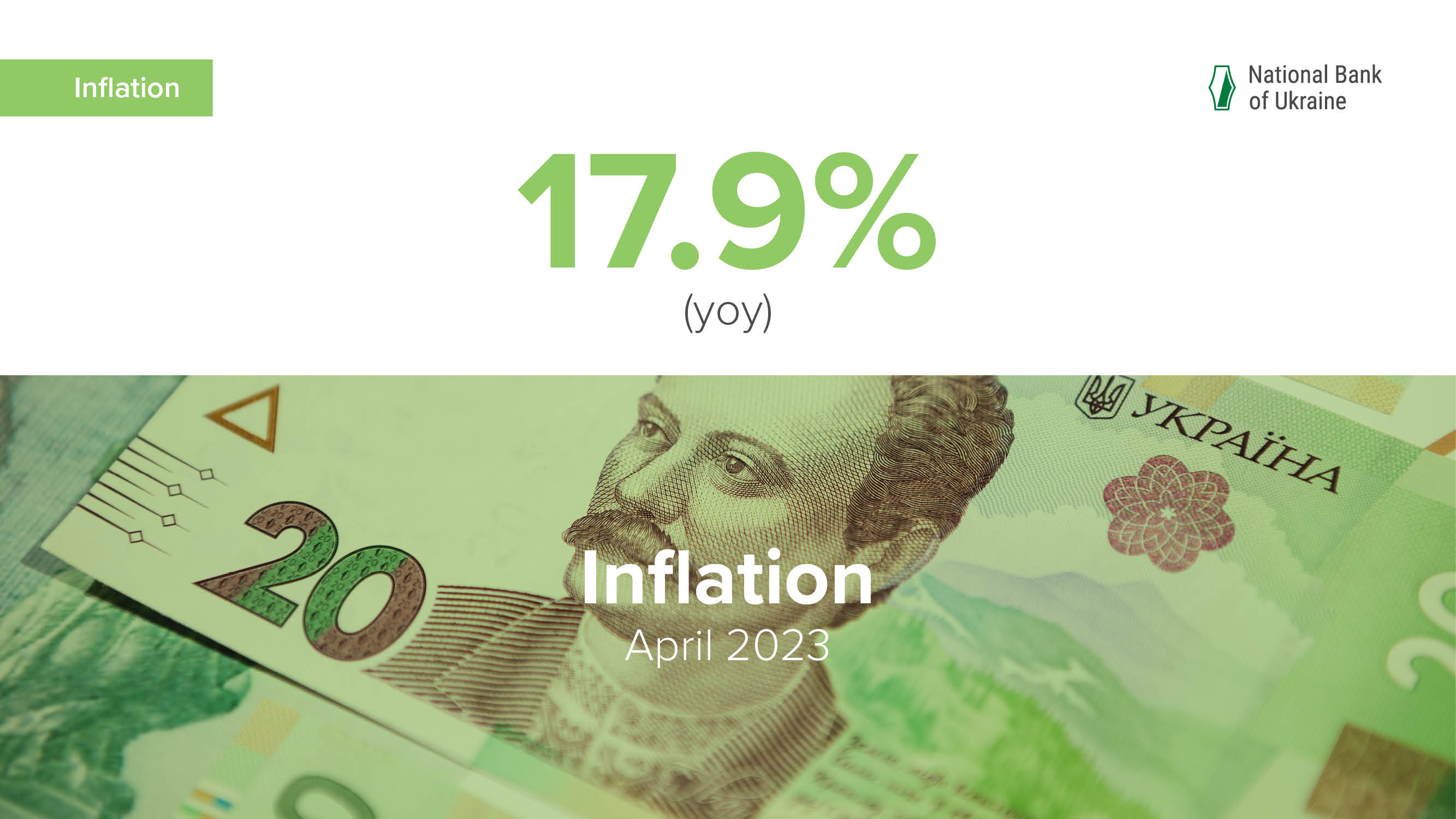In April 2023, consumer inflation in annual terms continued to slow to 17.9% yoy, down from 21.3% yoy in March. In monthly terms, prices grew by 0.2%. This is according to data published by the State Statistics Service of Ukraine.
The actual rates of price growth were slightly below the trajectory of the NBU’s forecast published in the April 2023 Inflation Report. Price increases were restrained by the greater-than-expected supply of foods and fuels. Inflation slowed because of the strengthening of the hryvnia in the cash FX market and the improvement of inflationary expectations. The slowdown was also primarily due to base effects from last year, when inflation began to accelerate rapidly after the onset of the full-scale invasion.
Core inflation decreased to 16.9% yoy in April, down from 19.8% yoy in March
The rise in the prices of processed foods significantly decelerated, to 19.2% yoy. As with previous months, the slowdown was driven by decelerated growth in raw material and fuel prices and the recovery of logistic and production chains, in particular against the backdrop of stable energy sector conditions. Specifically, the deceleration continued of the growth in prices for bread and flour products, confectionery and sausage products, beverages and canned foods. The pullback in global prices amid weak demand, as well as uncertainty around potential disruptions to food deliveries through neighboring EU countries, slowed the growth in prices for dairy products and sunflower oil. The improvement in exchange rate expectations amid a stronger hryvnia in the cash segment contributed to the decline in the pace of price increases for imported products.
The growth in prices for nonfood products also decelerated significantly (15.5% yoy). Last year’s base effects and improved exchange-rate and inflation expectations contributed to slower growth in prices for personal care products, clothing and footwear, electronic devices, pharmaceuticals, furniture, household appliances, home goods, and cars.
The growth in services prices remained almost unchanged (15.2% yoy). Price increases for the services of cafes and restaurants continued to decelerate as cost pressures eased amid stable energy sector conditions. In addition, housing rentals, home repair and maintenance prices, dry-cleaning prices, and car maintenance prices grew more slowly due to weaker demand. By contrast, prices for healthcare, insurance, telecommunications, and beauty salon services grew faster, driven in part by the gradual recovery of demand amid a restrained supply.
The growth in raw food prices slowed to 26.2% yoy
Milk prices grew more slowly due to sufficient supply against the backdrop of weak demand and uncertainty around potential disruptions of transport and exports.
Cereal and flour prices decreased in annual terms, while the growth in sugar prices decelerated as last year's harvests met domestic needs.
A decrease in import prices and a favorable situation in the FX market led to a sharp slowdown in price increases for citrus fruits and bananas.
The growth in prices for greenhouse and imported vegetables slowed, mainly due to expanded supply. Meanwhile, prices for the vegetables used in the cooking of borshch rose at a higher pace: cabbage rose in price faster due to an off-season drop in the supply of its early varieties, and prices for onions and carrots grew more quickly because of the drawdown of stocks from last year.
Despite a seasonal expansion of egg supply, particularly from households, which led to a significant fall in egg prices in late April, the increase in egg prices accelerated in year-on-year terms, reflecting last year’s low base effect.
The higher rate of increase in meat prices can be explained away by limited production capacities and low imports amid rising world prices.
The increase in administered prices slowed to 10.9% yoy
Tobacco products rose in price more slowly, probably under pressure from illegal products. The sharp slowdown in the growth of prices for alcoholic beverages was due to last year’s base effects. The growth in prices for transportation services slowed as well thanks to the stabilization of fuel prices. The moratorium on raising utility prices for households continued to restrain the increase in administered prices.
Growth rates of fuel prices continued to decline, to 24.2% yoy
This is primarily attributable to the presence of significant stocks accumulated in previous months, when global oil prices were lower.
Inflation continues to ease due to the significant supply of foods, sufficient fuel stocks, and improved exchange-rate and inflation expectations. The upbeat outlook is driven, among other things, by the NBU’s consistent monetary policy aimed at maintaining exchange rate sustainability and making hryvnia-denominated savings more attractive. To maintain exchange rate sustainability, improve expectations, and steadily reduce inflation, the NBU will continue to ensure the necessary monetary conditions.







